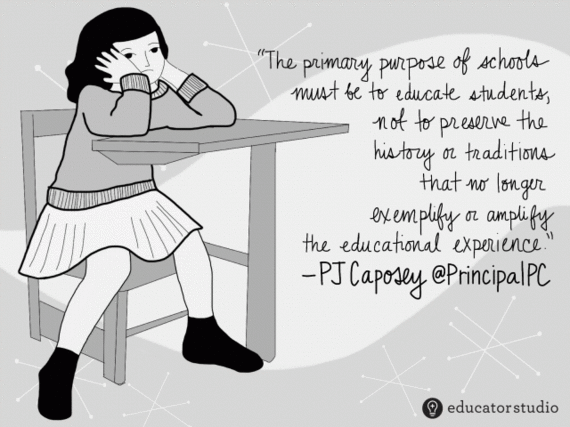Technology and social media continue to dramatically change the way we live and work. Social media in particular can be a great equalizer by enabling job seekers to connect with influencers outside of traditional offline social networks. Given its importance, why isn't this technology playing a stronger role in the curricula of our schools? For an insider's view, I spoke with PJ Caposey, principal and assistant superintendent at Stillman Valley schools in rural Illinois. PJ is the author of Teach Smart and winner of the 2013 Outstanding Young Educator Award.
Since PJ remembers his own initial reluctance with social media, he can understand how educators feel as they are encouraged to teach the technology. He had not been a huge fan of Facebook and considered Twitter to be a celebrity voyeur village, unlikely to sustain success in the adult market. Nonetheless, PJ gave Twitter a try one day while killing time at an airport playing fantasy football. It was interesting, but not game changing. There was no hint that social media would one day change his professional career.
A few months later PJ submitted a blog entry to a well-respected education website. He understood the importance of blogs, but differentiated them from social media. This particular submission required a Twitter handle. Based on his casual Twitter experience, he was able to quickly create the handle @Principalpc. As he fulfilled this requirement for the blog, PJ realized for the first time that social media might be an important means for sharing ideas on education.
PJ sincerely feels Twitter has since changed his life. In just two years, he has received twitter-generated job offers, book publishing contracts, consulting opportunities, and constant on-demand learning whenever and wherever he chooses. Most importantly, Twitter and social media have provided PJ with the opportunity to meet and share ideas with thousands of people - many of whom have become his friends.
Now that he is comfortable with social media, PJ tries not to forget how he felt just two years ago - resistant and even cynical. "While social media may seem like a hard sell, especially to people older than Generation Y, I do not think it is any harder to sell than other forms of technology that disrupt our lives," reflects PJ.
PJ remembers when text messaging first came along; another fad that many people felt wouldn't change the way people interact and communicate. "I remember vividly the day that I received my first text message from my parents and thinking - they finally converted!" says PJ. "I think all of us have gone through the experience of adopting a new technology and then waiting for the others to join. The moment we embrace a new technology we suddenly become frustrated with those who have not."
Technology will win in a big way in the educational arena in the coming years; and it must in order for our students to stay competitive. The question is who will enthusiastically embrace the change, who will begrudgingly, but none-the-less accept it, and who will abstain and die standing their ground. The future of technology in schools will not be a case of the have and have-nots in terms of money, but a case of the have and have-nots in terms of leadership.
Why Change Can Be Difficult in Education
Teaching is like parenting in that we teachers experience 17+ years of modeling before getting a chance to spread our wings. During that time, a future educator witnesses thousands of hours of both outstanding and not so outstanding instruction. While the experience of figuring out what works and what does not may sound like an advantage, it can also be a roadblock in the educational landscape. Sometimes new teachers have old, left-over ideas as to how to ply their trade. For example, at this moment, how many new teachers have experienced another teacher using social media for education while they were in school?
Call for Leadership
Given that change is necessary, PJ feels there is not yet enough being done to promote the transformation to a technology-friendly 21st century school community by the leaders of our schools. As a school leader, he believes it must start there. In the words of educational writer and speaker, Todd Whitaker, "If the principal sneezes, the whole school catches a cold." It is up to the educational leaders to set the tone that technology, social media, and overall connectedness should not be feared. Rather they must be incorporated into the curriculum so that the students become comfortable, proficient, and responsible with it. Since most teachers did not have the chance to experience it as students, they need to see their leaders and administrators using it in order to make the change.
The Bottom Line
Schools are no longer defined by brick and mortar walls or textbooks. More than ever, they need to teach creativity, innovation, and how to find and verify meaningful information. Schools especially should be teaching important communication skills; not just how to stand awkwardly in the front of the classroom giving a speech, but how to communicate coast-to-coast and country-to-country in discussion and collaboration. Students need to learn how to debate ideas and concepts (not people) and weigh their positions on important and relevant topics. Schools will continue to be relevant as they embrace these changes.
The experience PJ has had with social media is the same experience schools need to be providing their students. Leaders must promote social media and digital citizenship so the educational community can move beyond the mentality of fear and dreaded what-ifs, to adopt a philosophy of innovation and why-nots. Now is the time for leaders to embrace the new technology by personally experiencing the benefits of connectedness and technology and becoming transformational leaders for the children and communities they serve.
This post was co-authored by PJ Caposey, principal and assistant superintendent at Stillman Valley, Illinois.

